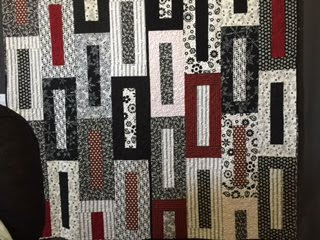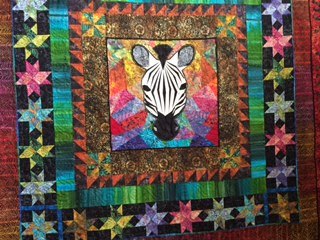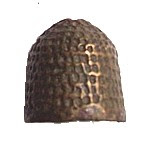If you didn't get a chance to visit the lovely display of quilts at Lancefield this weekend you might enjoy these photos. It is always good to support other local groups and applaud the great effort that goes in to organising such events. I know some of these ladies will be attending our Quilt-In. I did see some familiar faces viewing the proceedings. The Lancefield group does not publish the names of the makers on their quilts. It's an interesting idea to ponder??????











_________________________________________________________________________________
Many moons ago Lyn sent me this little picture of a medieval thimble that her daughter had found on the internet. Until now it has been lost in my internet space but lo and behold it surfaced today. The humble thimble has a very interesting story



Thimbles
Thimbles have also been used for centuries. The dimples in the surface allowed the thimble to protect the finger while pushing a needle through fabric or leather. A thimble is generally made out of strong leather or metal, although some older manufacturers used horn and ivory. Prior to the 18th century, the dimples were hand punched, sometimes in a decorative pattern, but more usually to cover the entire wall surface.
The large thimble to the left is an example of a brass, domed thimble from my own collection. It has hand drilled holes and dates to the 14th-15th century. The second thimble shown at the right is also from London, England from the 14th century, also both constructed from brass and has a small hole at the top which may or may not have been acquired in the manufacturing process.
 The silver thimble at the right is also from London, England and is hand-punched. It is silver-gilt and bears an inscribed motto in medieval French, "MA JO IE" which means my joy. It also has engraved leaves. Such in item would have been quite expensive and used for fine work by a wealthy woman.
The silver thimble at the right is also from London, England and is hand-punched. It is silver-gilt and bears an inscribed motto in medieval French, "MA JO IE" which means my joy. It also has engraved leaves. Such in item would have been quite expensive and used for fine work by a wealthy woman.

The thimble at left is known as a ring thimble because its design and open top lets it be worn on the finger like a ring. It is made of brass and dated to the late 15th century England.
_________________________________________________________________________________
Many moons ago Lyn sent me this little picture of a medieval thimble that her daughter had found on the internet. Until now it has been lost in my internet space but lo and behold it surfaced today. The humble thimble has a very interesting story

The following information is taken from this sitewhere you will find lots of interesting information about ancient sewing tools.

Thimbles
Thimbles have also been used for centuries. The dimples in the surface allowed the thimble to protect the finger while pushing a needle through fabric or leather. A thimble is generally made out of strong leather or metal, although some older manufacturers used horn and ivory. Prior to the 18th century, the dimples were hand punched, sometimes in a decorative pattern, but more usually to cover the entire wall surface.
The large thimble to the left is an example of a brass, domed thimble from my own collection. It has hand drilled holes and dates to the 14th-15th century. The second thimble shown at the right is also from London, England from the 14th century, also both constructed from brass and has a small hole at the top which may or may not have been acquired in the manufacturing process.
The thimble at left is known as a ring thimble because its design and open top lets it be worn on the finger like a ring. It is made of brass and dated to the late 15th century England.

No comments:
Post a Comment
Thanks for your lovely comment! We love to hear what you think of goings on and will always try very hard to reply. To help us to do this, please make sure your email address is enabled in your Google ID. x